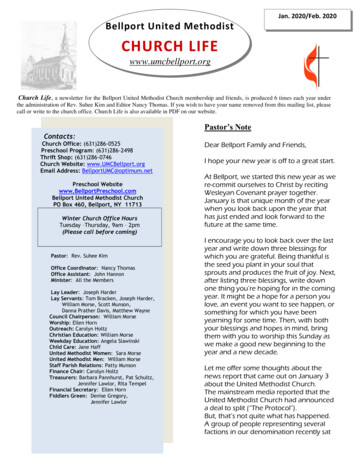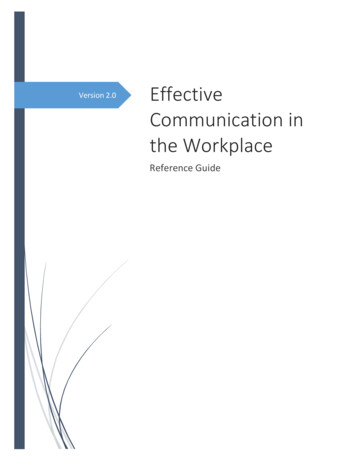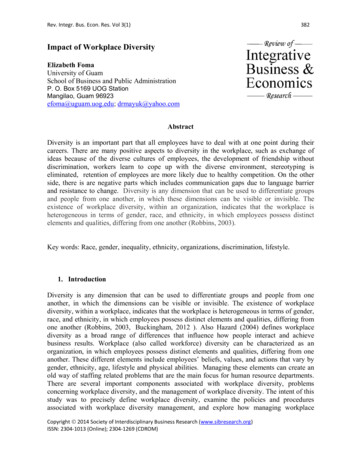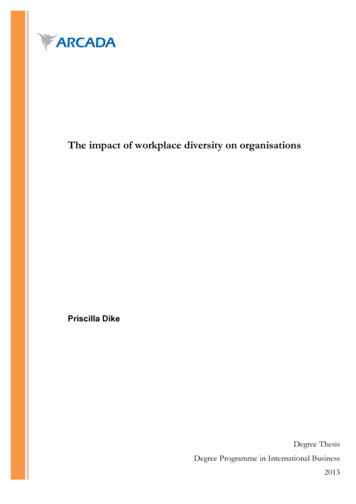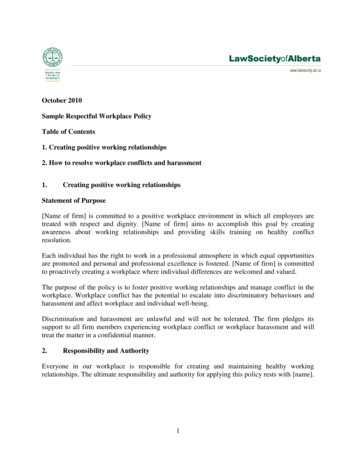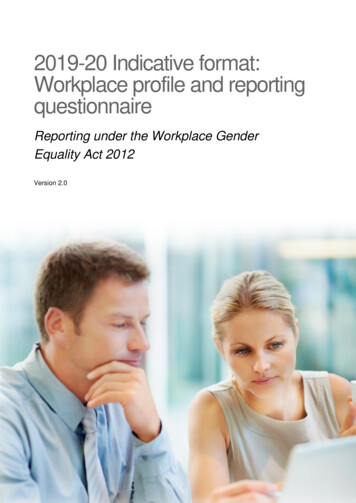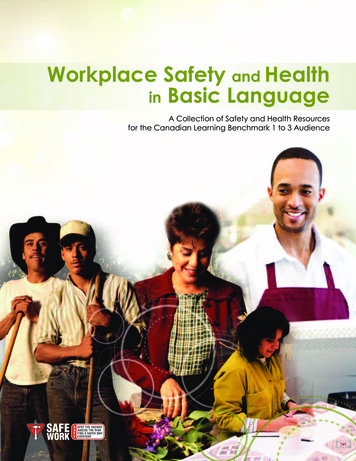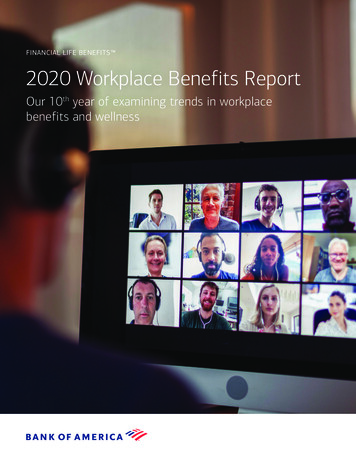
Transcription
FINANCIAL LIFE BENEFITS 2020 Workplace Benefits ReportOur 10th year of examining trends in workplacebenefits and wellness
Looking towards the futureof Workplace BenefitsAfter 10 years of conducting research to inform our annualWorkplace Benefits Report, the Retirement and Benefit PlanServices team has learned a lot about how employers lookat benefits and financial wellness programs, and even howemployees feel about their own financial situation. Theinsights we have gleaned have helped us enhance our benefitplan offering, innovate new financial wellness solutions andeducate employers so they can do more to help support theiremployees’ financial wellness.financial goals, but also with ways to improve their overallwellness, including their mental and physical well-being.The coronavirus is affecting us all and has brought the idea ofholistic wellness into sharper focus, which is a trend that weare increasingly focusing on as the next frontier in workplacewellness programs.The most exciting news as we look back is how workplacefinancial wellness programs have grown in prevalence,size and scope. More and more employers — regardlessof revenue or size of workforce — are embracing theseprograms as integral to their benefits offering. And they areexpanding these programs to go beyond simple retirementsavings to address the full range of financial needs.Employers are also seeing the connection between employeefinancial wellness and productivity — and how critical theseprograms are to business success.We were already in the process of collecting data for thisyear’s report when the coronavirus really started to take holdin the United States, and employers and employees werefaced with restrictions and stay-at-home orders. We sawearly indications that the virus and the related economicresults did have an impact on feelings of wellness, and weexpect these effects to last for the foreseeable future. We arecommitted to continuing to monitor how these trends playout, as well as continuing to explore all aspects of workplacewellness. And we are equally committed to continuing toshare our findings with employers — to help them makeinformed decisions about their workplace wellness offeringand to better serve the needs of their employees.And while employees have shown great strides in beingbetter prepared to manage their finances and take necessarysteps to improve their financial wellness, there are employeeswho may need additional support or guidance — especiallywomen and younger generations. Employees are also lookingfor help not only with a wide range of short- and long-termLorna SabbiaHead of Retirement and Benefit Plan ServicesBank of America is a marketing name for the Retirement Services business of Bank of America Corporation (“BofA Corp.”). Banking activities may be performed by wholly ownedbanking affiliates of BofA Corp., including Bank of America, N.A., Member FDIC. Brokerage and investment advisory services are provided by wholly owned non bank affiliates ofBofA Corp., including Merrill Lynch, Pierce, Fenner & Smith Incorporated (also referred to as “MLPF&S” or “Merrill”), a dually registered broker-dealer and investment adviser andMember SIPC.Investment products:Are Not FDIC InsuredAre Not Bank GuaranteedMay Lose Value
In this year’s reportA look back at 10 years of financial wellness . 4The current state of employee financial wellness . 8The impact of debt in pursuing financial goals . 14Healthcare is still a blind spot in long-term financial success. 17Employees are hungry for help . 20Expanding workplace wellness beyond financial concerns . 22Action steps for employers . 26How Financial Life Benefits can elevate workplace benefits . 2762%83%49%59%67%47%of employers feel extremeresponsibility for theiremployees’ financial wellness,up from 13% in 20131of employees say they arefeeling financially welltoday, down from 61% justtwo years ago2of eligible employeescontribute to their HealthSavings Account (HSA)12of employers believefinancial wellness tools leadto greater productivityof employees say they don’thave control over their debt,likely contributing to reducedfeelings of financial wellnessof employers are promotingworkplace wellness withestablished diversity andinclusion programsSource: Bank of America, 2013 Workplace Benefits Report, 2013.Source: Bank of America, 2018 Workplace Benefits Report, 2018.2020 WORKPLACE BENEFITS REPORT 3
Workplace WellnessThe last decade has seen impressivegrowth in workplace wellnessTen years ago, Bank of America expanded our relationship withemployers across the country through research on how theyapproached employee benefits programs and financialwellness in the workplace. Through open dialogue withdecision makers, we believed we could gather insights thatwould let us better serve them and — in turn — theiremployees. The insights we have gathered have helpedemployers make more informed decisions about the benefitsthey offer and have also helped Bank of America innovate,creating new services and benefit offerings that address theexpressed needs of employers and employees.Over the years we have conducted this research, the datashows us that employees’ senses of financial wellness andcompany health are interconnected. Employee financialwellness has a direct impact on overall happiness and4 2020 WORKPLACE BENEFITS REPORTproductivity. And employers who include financial wellness aspart of their benefits program have more focused andmotivated employees.During this time, we have also seen a continued movementaway from company-funded benefits towards more selfdirected options — especially in the areas of retirement andhealthcare. In turn, an increasing number of employers of allsizes have started to offer financial wellness programs as wellas assistance with non-financial concerns, like healthcare.Employers realize that they need to be the ones to bridge thegap and provide tools and guidance that help deliver moreholistic support for employees across topics. Some employersare going even further and expanding support to more fullyaddress the whole employee, including additional benefits thatsupport physical and mental wellness.
Workplace WellnessThe coronavirus brings the topic of holistic well-being intosharper focusThe additional stresses related to the coronavirus have elevated the topic of well-being in many ways.Employees are likely facing increased stress levels, greater demands on their time and potentially theadded complexity of simultaneously working from home and serving as a full-time caregiver.While the effects of these unprecedented times have yet to be fully understood, employees have alreadynoted an increased strain on their physical and mental health, a greater impact on the interactionsbetween all aspects of their well-being and increased impact of overall well-being on productivity.These trends are likely to continue until things return to normal — underscoring the importanceof employers thinking more about how they can better support overall well-being to mitigate theeffect on their employees and their firm.Employers are taking a larger role in supporting financial wellness3The good news is that we are seeing a significant increase inthe responsibility employers take in helping their employeesfeel financially well. Since we first asked employers, thenumber that feel an extreme responsibility has grown morethan fourfold. And employers’ sense of responsibility is evengreater when it comes to retirement-related topics. Today,the majority of employers understand that helping theiremployees on the path toward financial wellness is not a “niceto have,” but an integral part of how they attract and retaintalent as well as ensure a happy and productive workplace.80%78%In 202062%13%of employers feel extreme responsibilityfor their employees’ financial wellness333%In 201322%20202012Percentage of employerswho feel very/extremelyresponsible for helpingemployees withretirement healthcareneeds/costs20202012Percentage of employerswho feel very/extremelyresponsible for helpingemployees withsustaining assetsthrough retirementSource: Bank of America, 2012 Workplace Benefits Report, 2012.2020 WORKPLACE BENEFITS REPORT 5
Workplace WellnessEven more impressive is how workplace financial wellness has grown to address the full range of employee financial concerns.Workplace wellness programs have expanded to go beyond retirement planning and now address a wider range of financialtopics — from healthcare costs to debt management — that all affect an employee’s sense of financial well-being.The range of topics financial wellness plans cover has increased significantly4Saving forretirement2020Planning forhealthcare costs2020BudgetingSaving %2020201313%2020201354%15%Financial wellness is now an essential workplace benefitThe growth of financial wellness programs in the workplace also means that expectations have shifted. At companies of allsizes, employees expect benefits programs that go beyond the basics. Employees now want to see education and support thatwill help them not just save for retirement, but also help with everyday financial decisions — from making retirement savingslast to managing healthcare costs, managing debt more effectively, using budgeting and saving techniques and balancingcompeting financial goals.While many employers feel a genuine responsibility to help their employees manage their financial wellness, good business reasonshave also driven the expansion of these programs.Growth in financial wellness is seen to deliver tangible resultsAnd when they are asked, more than8 in 10 employersacross companies large and small indicate theybelieve that employee financial wellness helps deliver:4Source: Bank of America, 2013 Workplace Benefits Report, 2013.6 2020 WORKPLACE BENEFITS yMoresatisfiedemployeesMoreengagedemployees
Workplace WellnessWellness is dynamic and evolvingThe most impactful programs are those that are comprehensive and address the full rangeof employee needs. This requires a more responsive plan design as well as tools andaccess to advice that can help address each employee’s unique needs — and provide themwith personalized guidance on how to pursue their goals. And because feelings of wellnessare increasingly multidimensional, wellness benefits should consider factors beyond thefinancial and address more holistic definitions of wellness.The data shared as part of the Workplace Benefits Report is designed to help connectemployers with information about employee needs and desires. That is why we continue tolook at both financial and non-financial topics. Armed with insight on the mindset of theiremployee base, employers can make more informed decisions and better help theiremployees achieve wellness in its many forms.2020 WORKPLACE BENEFITS REPORT 7
Financial WellnessWhile workplace support is growing,financial wellness is fallingWhile we have seen a sustained increase in the offering offinancial wellness programs, employee financial wellness hasdeclined. Financial wellness can be influenced by a wide rangeof factors and is likely to fluctuate over time as employeegoals and priorities change. The goal of any financial wellnessprogram is to promote good habits and positive financialdecision-making to help employees navigate changing marketenvironments and better manage their evolving goals — whichis even more important as the coronavirus creates newchallenges to maintaining financial wellness.56Source: Bank of America, 2018 Workplace Benefits Report, 2018.Source: Bank of America, 2019 Workplace Benefits Report, 2019.8 2020 WORKPLACE BENEFITS REPORTThe number of employees who rate their financialwellness as good or excellent is declining5,661%200855%200949%2020
Financial WellnessFinancial wellness programs also need to accommodate the fact that different employees may need different levels of support.Women tend to lag their male counterparts in feeling financially well — exacerbated by the fact that women often make less thantheir male counterparts and are more likely to take time out of the workforce to raise a child or provide care for a family member.And younger employees tend to lag their older counterparts, likely driven by fewer years in the workforce and less experiencepursuing their financial goals.Percentage of employees who rate their financial wellness as good or excellent41%58%41%38%60%WomenMenGen Z &MillennialsGen XBaby Boomers &Silent GenerationAcross the generations, goals differ as well.Youngergenerationswhile olderemployeestend to be more focused on short- to medium-term goals,like paying off credit cards or making a home purchase,tend to be more focused on long-term goalslike retirement.The top 3 financial goals for:Gen Z & MillennialsGen X123123Paying off credit card debtBuying my first houseGrowing savings to pay forunexpected expensesBaby Boomers & Silent GenerationSaving for retirementPaying off credit card debtGrowing savings to pay forunexpected expenses123Saving for retirementPaying off a mortgagePaying off credit card debt2020 WORKPLACE BENEFITS REPORT 9
Financial WellnessAgain, when looking at their goals, women tend to differ significantly from men, with a focus on more short-term needs at theexpense of their long-term goals. This is especially significant when you look at life expectancy where women, on average, tend tolive six to eight years longer than men.7Women are more than twice aslikely to rank paying off creditcard debt in their top 3 goals721%%2199%%WomenMenWomen’s top 3 financial goalsMen’s top 3 financial goals123123Saving for retirementPaying off credit card debtGrowing savings to pay forunexpected expensesSource: World Health Organization, Global Health Observatory: Women’s Life Expectancy, 2020.10 2020 WORKPLACE BENEFITS REPORTSaving for retirementPaying off a mortgageGrowing savings to pay forunexpected expenses
Financial WellnessRegardless of where they are focused, employees have a way to goIn addition to asking about their feelings of financial wellness, it is also important to ask employees how they feel they are doingwhen it comes to achieving their goals. Irrespective of what their goals are, less than four in 10 employees would say that theyhave made significant progress towards those goals. Employees feel they have made the most progress towards saving forretirement, while short-term goals like debt management and purchasing a first home rank near the bottom of the list.Few employees say they have made significant progress towards their goalsSaving for retirement38%Caring for a parent or family member34%Paying for current or future healthcare costs33%Growing savings to pay for unexpected expenses33%Paying off a mortgage26%Paying off credit card debt19%Paying off student loans16%Buying my first houseSaving for college15%12%More surprising is the stark difference among the generations on feelings of progress. Baby Boomers and the Silent Generationfar outstrip others in their sense of progress. Gen Xers tend to have feelings of progress that are similar to their youngercounterparts, potentially indicating a lack of progress among members of this generation.Feelings of progress differ across generationsGen Z & MillennialsGen XBaby Boomers &Silent 22%2247%%47Saving for retirementPaying for current/futurehealthcare expensesGrowing savings to payfor unexpected expenses2020 WORKPLACE BENEFITS REPORT 11
Financial WellnessA sense of being cash-strapped is likely contributing to these challengesThe top reason employees cite as to why they have not made more progress towards their goals is a purely economic one —they feel they don’t have any spare money left after their monthly expenses. This feeling is higher among women and youngeremployees, further underscoring the need for financial wellness programs to address both employees’ short- and long-term financialgoals. When employees struggle to meet their short-term financial obligations, they are less likely to be able to focus on theirlong-term goals. Helping employees address topics like budgeting and saving, as well as retirement, may help create a sense ofconfidence and offer actionable skills that can help them allocate their income differently so they can achieve more of their goals.7%8%Not sure what myfirst step shouldbe, or how to takethat first step12%I’m afraid ofmaking a mistakeso I tend to donothingI’m unsurehow to prioritizemy finances38%I don’t have any sparemoney after mymonthly expenses8%I don’t knowwhere to startWomen are nearly twice as likely to cite not having sparemoney after monthly expenses as their main challenge.47%18%I’m focused on othernon-financial needsthat are more pressingSimilarly, younger employees are also morelikely to feel cash-strapped.54%44%27%Men23%Women12 2020 WORKPLACE BENEFITS REPORTGen Z &MillennialsGen XBaby Boomers& SilentGeneration
Financial Wellness2020 WORKPLACE BENEFITS REPORT 13
Debt ManagementDebt management plays a significantrole in financial wellnessIn addition to a sense that they don’t have any spare money left at the end of the month, lack of control over their debt maybe preventing employees from making progress towards their financial goals. Debt maintenance costs eat into funds thatcould be used towards current expenses or long-term savings goals. And debts can also have an emotional price, eroding asense of overall well-being. Nearly six in 10 employees say they do not have a high level of control over their debt, and nearlyfour in 10 say it affects their ability to achieve their financial goals.59%14 2020 WORKPLACE BENEFITS REPORTof employeessay they do nothave a high levelof control overtheir debt36%of employeessay their debt hasgreatly affectedtheir ability to meettheir financial goals
Debt ManagementLooking at debt brings into sharper focus how women lag their malecounterparts. Women are more likely to feel they lack control of theirdebts and view it as an obstacle to their other goals.Men are more likely to feelin control of their debtsWomen are more likely toview debt as an d similar to overall feelings of financial well-being, younger employeesmirror women with similar concerns about the challenges debt causes inpursuing their other goals.Younger generations also view debt as an obstacle to their other goals44%43%27%Gen Z &MillennialsGen XBaby Boomers &Silent Generation2020 WORKPLACE BENEFITS REPORT 15
Debt ManagementDebt management is a multifaceted, yet almost universal, challengeFewer than one in five employees say they are completely debt-free. Given the prevalence of employees having to balancedebt management with current expenses and planning for the future, financial wellness is inexorably linked to debtmanagement. The nature of the debt employees have also varied. While “good” debt — like a mortgage — is common, creditcard debt tops the list.Employees are managing a variety of debtCredit card debt50%Mortgage46%Student loan21%Healthcare/medical debtOnly15%Other typesof debt18%13%Home equity lineof employees saythey are completelydebt free9%Personal loan fromfamily or friends6%Given the short term and potentially high interest associated with credit card debt, it is no wonder that it has an impact onemployees’ ability to manage their other goals. This underscores the importance for financial wellness programs to addressdebt to help employees take control — in a way that increases their ability to focus on longer-term objectives.Women ma
gap and provide tools and guidance that help deliver more holistic support for employees across topics. Some employers are going even further and expanding support to more fully address the whole employee, including additional benefits that

